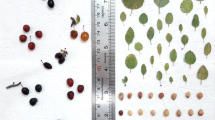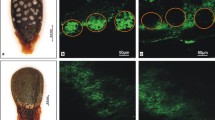Abstract
The genus Onobrychis Mill. is one of the most economically important members of the family Fabaceae, which has a complicated infrageneric taxonomy. The genus has been traditionally divided into two subgenera, in which species of each subgenus have been classified in some sections. In the present study, the macro- and micro-morphological characteristics of legumes in three sections of the subgenus Sisyrosema were evaluated using scanning electron microscopy and light microscopy techniques. In total, 10 qualitative and quantitative traits were examined with 15 replicates per trait. PAST software and the multivariate statistical program were used for statistical data analyses. All taxa have one-segmented legumes, and their dimensions significantly vary among the taxa. The legume's shape varied between elliptic, circular, semicircular, and reniform, however; the most common shape was detected as reniform. Additionally, fruit in half of the taxa had dorsi-ventral symmetry. The legume outline view was detected as plumose, smooth, and short hispid, with the plumose as the abundant form. The exocarp surface indumentum was observed as glabrous, plumose (the most frequently-occurring shape), tomentose, pilose, villous, pubescent, puberulouse, plumose + villous, and short hispid + silky. The exocarp sculpturing pattern was observed as uni-formed reticulate (Afghanica and Heliobrychis) and hetero-formed reticulate (Hymenobrychis). In some cases, the taxa classification pattern did not follow species grouping in sections according to Flora Iranica. All the examined traits present a lack of taxonomic value at the section level. Among the characteristics, legumes shape and exocarp sculpturing patterns can be considered as diagnostic traits at the species level. However, the indumentum type, color, and shape of legumes, and their dorsi-ventral symmetry have limited taxonomic value at the infraspecific level. Our results support the non-monophyly hypothesis of these sections, however, the taxonomic level of some infraspecific taxa must be updated to species.







Similar content being viewed by others
References
Agbagwa IO, Okoli BE (2005) Fruit Epidermal Micromorphology in the Systematics of Abrus Adanson (Papilionaceae) in Parts of Tropical West Africa. Asian J Plant Sci 4:652–659.
Ahangarian S, Kazempour Osaloo SH, Maassoumi AA (2007) Molecular phylogeny of the Hrdysareae with special reference to Onobrychis (Fabaceae) as inferred from nr DNA ITS sequences. Iran J Biotechnol 13(2):64–74
Amirahmadi A, Kazempour-Osaloo S, Kaveh A, Maassoumi AA, Naderi R (2016) The phylogeny and new classification of the genus Onobrychis (Fabaceae-Hedysareae): evidence from molecular data. Plant Syst Evol 302:1445–1456. https://doi.org/10.1007/s00606-016-1343-1.
Amirabadizadeh H, Jafari A, Mahmodzadeh Akherat H, Ghanavati F (2009) Study of pollen grain morphology in perennial species of sainfoin (Onobrychis) of Khorasan province. Iran J Crop Sci 11(1):1–14
Arsalan A, Ertugrul K (2010) Genetic relationships of the genera Onobrychis, Hedysarum, and Sartoria using seed storage proteins. Turk J Biol 34:67–73
Avci S, Tekin N, Sancak C, Özcan S, Marangi AO (2016) Phylogenetic relationship of some Onobrychis taxa naturally grown in Turkey based on morphology and nuclear ribosomal DNA. Legum Res 39:665–673
da Silva Gomes G (2018) Taxonomy of Subfamily Caesalpinioideae (Fabaceae Lindl) In Cerrado Fragment In The East From Maranhão, Northeast From Brazil Journal of Pharmaceutical and Biological Sciences 13(4): 39–50.
Gabr DG (2018) Significance of fruit and seed coat morphology in taxonomy and identification for some species of Brassicaceae. Am J Plant Sci 9:380–402
Ganie AH, Reshi ZA, Wafai BA, Khuroo AA (2017) Fruit morphology of the genus Potamogeton L. in Kashmir Himalaya and its utility in taxonomic delimitation. J Asia-Pacific Biodivers 10:274e278
Ghanavati F, Nematpajooh N (2012) Study of ploidy level of annual species of Onobrychis in Iran. Caryologia 65(4):328–334. https://doi.org/10.1080/00087114.2012.760880
Ghanavati F, Eskandari H, Bakhshi Khaniki GH, Sorkhi B, Amirabadizadeh H (2010) Karyotypic Study of Sect. Hymenobrychis of Onobrychis in Iran. J Behnejadi Nahal Va Bazr. 26(4):545–560
Gurgel ESC (2009) Morfoanatomia, perfil químico e atividade alelopática de três espécies de Copaifera L. (Leguminosae Caesalpinioideae) nativas da Amazônia. PhD dissertation. Manaus, Instituto Nacional de Pesquisas da Amazônia, Universidade Federal do Amazonas.
Hajmoradi F, Ranjbar M, Waycott M, van Dijk K (2016) Phylogeny of Onobrychis sect. Hymenobrychis (Fabaceae) based on chloroplast DNA sequence data. Iran J Genet Plant Breed 5(2):11–22
Hatami A, Nasirzadeh AR (2006) Change in rank position of two Onobrychis subspecies according to morphological and karyotypic studies in Fars province. Paj Saz 75:186–191
Hejazi H, Mohsen S, Nasab MZ (2010) Cytotaxonomy of some Onobrychis (Fabaceae) species and populations in Iran. Caryologia 63:18–31
Higgs NT (1991) Practical and innovative uses of correspondence analysis. Statistician 40:183–194
Hosgoren H (2006) Total numbers of chromosome numbers in species of Onobrychis Miller (Fabaceae) in Southeastern Anatoliaregion. Bioctechnol Biotecnol Equip J 20(2):57–61
Kaveh A, Kazempour-Osaloo S, Amirahmadi A, Maassoumi A, Schneeweiss GM (2018) Systematics of Onobrychis sect. Heliobrychis (Fabaceae): morphology and molecular phylogeny revisited. Plant Syst Evol 305:33–48. https://doi.org/10.1007/s00606-018-1549-5
Kaya A, Ünal M, Sefal A, Martin E (2019) Fruit and seed macro- and micromorphologies of the genus Matthiola (Brassicaceae) in Turkey and their taxonomic value. Turk J Bot 43:516–528. https://doi.org/10.3906/bot-1812-10
Lewke-Bandara N, Papini A, Mosti S, Brown T, Smith LMJ (2013) A phylogenetic analysis of genus Onobrychis and its relationships within the tribe Hedysareae (Fabaceae). Turk J Bot 37:981–992. https://doi.org/10.3906/bot-1210-32
Liu X, Lu Z, Wu J et al (2023) Comparison of genetic impact on growth and wood traits between seedlings and clones from the same plus trees of Pinus koraiensis. J For Res 34:469–480. https://doi.org/10.1007/s11676-022-01480-7
Lock JM (2005) Tribe hedysarae. In: Lewis G, Schrire B, Mackinder B, Lock M (eds) Legumes of the world. Royal botanical gardens, Kew, pp 489–495
Mehregan I, Rahirninejad MR, Azizian D (2002) A taxonomic revision of the genus Medicago L. (Fabaceae) in Iran. Iran J Botany 9(2):207–221
Oliveira MLAA (1990) Adições para o gênero Desmodium Desvaux (Leguminosae-Faboideae) no Rio Grande do Sul, Brasil. Iheringia, Série Botânica 40:77–87
Parra P (1984) Estudio de la morfologia externa de plántulas de Calliandra gracillis, Mimosa albida, Mimosa arenosa, Mimosa camporum y Mimosa tenuiflora. Revista De La Facultad De Agronomía (maracay) 13:311–350
Podani J (2000) Introduction to the exploration of multivariate biological data. Backhuys Publishers, Leiden
Polhill RM (1981) Papilionoideae. In: Polhill RM, Raven PH, editors. Advances in legume systematics. Part 1. Kew, UK: Royal Botanic Gardens, pp. 367–370.
Ranjbar M, Karamian R, Afsari S (2010) Meiotic chromosome number and behaviour of Onobrychis avajensis (Fabaceae): a new species from western Iran. Plant Ecol Evol 143(2):170–175
Rechinger KH (1984) Onobrychis in Rechinger, K. H. Flora Iranica, no 157: 389–459. Akademische Druck-u.-Verlagsanstalt. Graz.
Rodrigues RS, Tozzi AMGA (2008) Systematic relevance of seedling morphology in Acosmium, Guianodendron, and Leptolobium (Leguminosae, Papilionoideae). Brittonia 60:287–296
Rodrigues RS, Hirt APM, Flores AS (2012) Morfologia de plântulas das espécies de Rhynchosia (Leguminosae, Papilionoideae) de Roraima, Brasil. Acta Botanica Brasilica 26:585–592
Roux Le MM, Boatwright JS, van Wyk BE (2013) A global infrageneric classification system for the genus Crotalaria (Leguminosae) based on molecular and morphological evidence. Taxon 65(2):957–971. https://doi.org/10.12705/625.1
Safaei-Chaeikar S, Ghanavati F, Naghavi MR, Amirabadi-zade H, Rabiee R (2014) Molecular phylogenetics of the Onobrychis genus (Fabaceae: Papilionoideae) using ITS and trnL–trnF DNA sequence data. Aust J Bot 62:235–250. https://doi.org/10.1071/BT13279
Simpson MG (2019) Plant Systematics, 3rd edn. Elsevier
Širjaev G (1926) Onobrychis generis revisio critica. Pars Prima Spisyprír Fak Masarykovy Univ 76:1–165
Song JH, Hong SP (2020) Fruit and seed micromorphology and its systematic significance in tribe Sorbarieae (Rosaceae). Plant Syst Evol 306:6. https://doi.org/10.1007/s00606-020-01640-4
Stearn William T (1992) Botanical Latin: history, grammar, syntax, terminology and vocabulary, 4th edn. Timber Press, Portland, Oregon
Talebi SM, Tabaripour R, Eskandari M (2019) Analysis of nutlet morphological characteristics of some Iranian Ajuga L. taxa. Biodiversitas 20:2833–2840. https://doi.org/10.13057/biodiv/d201008
Talebi SM, Azizi N, Yadegari P, Matsyura A (2020) Analysis of pollen morphological characteristics in Iranian Onobrychis Miller (Fabaceae) taxa. Braz J Botany 43:609–632. https://doi.org/10.1007/s40415-020-00623-6
Valenta K, Kalbitzer U, Razafimandimby D, Omeja P, Ayasse M, Chapman CA, Nevo O (2018) The evolution of fruit colour: phylogeny, abiotic factors and the role of mutualists. Sci Rep 8(1):1–8. https://doi.org/10.1038/s41598-018-32604-x
Wang X, Shen C, Meng P, Tan G, Lv L (2021) Analysis and review of trichomes in plants. BMC Plant Biol 21(1):1–11. https://doi.org/10.1186/s12870-021-02840-x
Xiao K, Mao X, Lin Y, Xu H, Zhu Y, Cai Q, Xie H, Zhang J (2016) Trichome, a functional diversity phenotype in plant. Mol Biol 6(1):1–6. https://doi.org/10.4172/2168-9547.1000183
Yembaturova EY, van Wyk BE, Tilney PM, Winter PJD (2010) The taxonomic significance of fruit morphology and anatomy in the genus Alepidea Delaroche (Apiaceae, subfamily Saniculoideae). Plant Divers Evol 128:369–385. https://doi.org/10.1127/1869-6155/2010/0128-0017
Yildiz B, Ciplak B, Aktoklu E (1999) Fruit morphology of sections of the genus Onobrychis Miller (Fabaceae) and its phylogenetic implications. Israel J Plant Sci 47(4):269–282
Yucel G, Betekhtin A, Cabi E, Tuna M, Hasterok R, Kolano B (2022) The Chromosome Number and rDNA Loci Evolution in Onobrychis (Fabaceae). Int J Mol Sci 23(19):11033. https://doi.org/10.3390/ijms231911033
Zarrabian M, Majidi MM (2015) Genetic diversity and relationships within and among Onobrychis species using molecular markers. Turk J Bot 39:681–692. https://doi.org/10.3906/bot-1406-47
Zeng CL, Wang JB, Liu AH, Wu XM (2004) Seed Coat Microsculpturing changes during seed development in diploid and amphiploid Brassica Species. Ann Bot 93:555–566. https://doi.org/10.1093/aob/mch080
Funding
Not appicable.
Author information
Authors and Affiliations
Contributions
N.A. performed the experiment and collected the data. S.M.T. supervised the research. R.T. and M.H advised the research and revised the manuscript critically. All authors read and approved the final manuscript.
Corresponding authors
Ethics declarations
Conflict of interest
The authors declare that there is no conflict of interest.
Additional information
Publisher's Note
Springer Nature remains neutral with regard to jurisdictional claims in published maps and institutional affiliations.
Rights and permissions
Springer Nature or its licensor (e.g. a society or other partner) holds exclusive rights to this article under a publishing agreement with the author(s) or other rightsholder(s); author self-archiving of the accepted manuscript version of this article is solely governed by the terms of such publishing agreement and applicable law.
About this article
Cite this article
Azizi, N., Talebi, S.M., Tabaripour, R. et al. Characterization of wild Onobrychis Mill. Subgenus Sisyrosema bunge (Fabaceae) germplasm resources from Iran using macro and micro-morphological traits. Genet Resour Crop Evol 71, 1795–1811 (2024). https://doi.org/10.1007/s10722-023-01734-1
Received:
Accepted:
Published:
Issue Date:
DOI: https://doi.org/10.1007/s10722-023-01734-1




